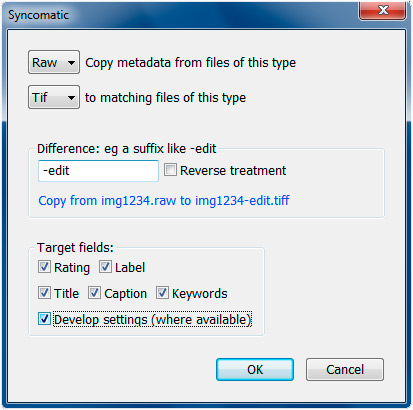Syncomatic plug-in – now syncs adjustments too
 I’ve just released a new version of my Syncomatic plug-in.
I’ve just released a new version of my Syncomatic plug-in.
Syncomatic’s original purpose was to tidy up metadata when you are faced with sets of pictures whose names match but whose metadata is out of sync. For instance you may have lots of TIFs or JPEGs which have been output from your raw files, but you then added keywords to the raw files. How do you then make 1234-edit.tif have the same keywords and other metadata as the original 1234.nef, make 1235-edit.tif the same as 1235.nef and so on? Syncomatic does that job.
It now does the same with adjustments (at least as many as it can).
Why would one want to do that? Well, for example, I was contacted by someone who had taken 15,000 pictures in a very short period, and sheer pressure of work had led him to switch his camera to Raw+JPEG and import only the JPEGs. He’d then added ratings, captioned and keyworded the JPEGs, done some quick adjustments, and submitted modified JPEGs to his clients. Now he was home and wanted to import his raw files and prepare stock and portfolio quality images from them. That was where he hit a wall. He could restore the raw files into the same folder as the JPEGs, and then synchronise the Lightroom folder – but Lightroom hides the JPEG and brings in the raw files without any IPTC metadata or adjustments. Even if one had saved the metadata back to the JPEGs, it wouldn’t really treat them like sidecars. The other approach for RAW+JPEG is to change the catalogue option so it imports separate files, but then there was the problem of copying the metadata and adjustments from each JPEG to its corresponding raw file. That’s why I updated Syncomatic.
Another possible application is when you have a new camera which has a raw file type which Lightroom doesn’t yet support. What you might do – after filing a complaint with the camera maker and demanding they offer a DNG option – is shoot Raw+JPEG, import the JPEG files, and add your metadata and adjustments. When Lightroom is updated, you can import the raw files and use Syncomatic to update them. I’m not sure if that will work in practice, but I suspect so.
Now, there are some limitations – but not many. Essentially I’m using the develop preset mechanism, so Syncomatic can only apply adjustments that you can save in a preset. Above all, that means cropping can’t be synchronised. But it does pretty well everything else, which isn’t too shabby.